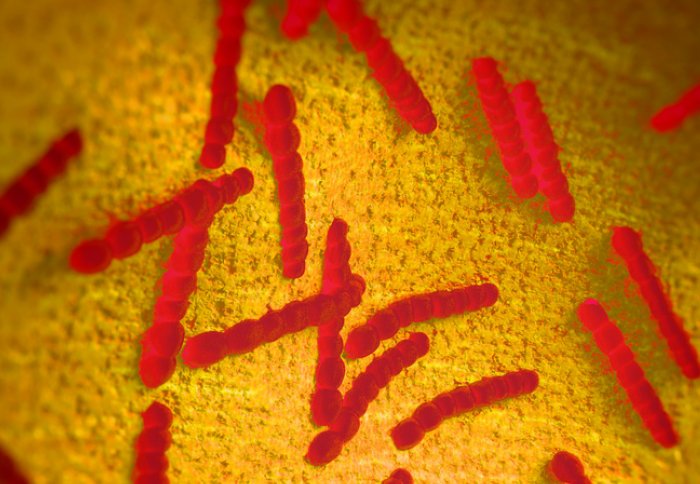
Pneumococcal bacteria colonies

The diverse 'coats' which protect a deadly microbe from our immune cells are generated by a 'hotspot' of rapidly evolving genes, a study has found.
Streptococcus pneumoniae are the most common bacterial cause of pneumonia, killing an estimated 500,000 children under the age of five each year. The bugs can also cause meningitis and blood poisoning in vulnerable patients.
Vaccines introduced over the last 20 years have been successful in reducing death rates by targeting the most lethal subtypes or ‘serotypes’ of pneumococcal bacteria – a handful of the estimated almost 100 identified. However, other strains of the bacteria not covered by the vaccines are becoming more common.
The vaccines that we currently use target a rapidly evolving complex of genes
– Dr Rafal Mostowy
Lead author, School of Public Health at Imperial College London
Now, a team led by researchers at Imperial College London has uncovered an ‘evolutionary hotspot’ in the bacterium’s genome which helps it to evade the human immune system by tweaking its outermost layer.
Their findings suggest the rapid rate of change in this region of DNA is a driving force behind the emergence of new serotypes – a process which could pose a challenge to future vaccine developments.
The researchers say that while there is strong evidence that vaccines provide good protection against pneumococcal pneumonia, a better understanding of how bacterial variation occurs at the genetic level could help scientists to stay one step ahead of the lethal bugs.
“Pneumococcal bacteria have been practicing evading the immune system for a very long time, so they are quite well adapted to changing their ‘appearance’ to overcome the challenge,” said Dr Rafal Mostowy, from the School of Public Health at Imperial, who led the research.
A key element which sets serotypes apart from one another is their capsule – the coat of densely-packed layers of sugars which envelopes the bacteria and acts like armour, protecting them from being identified and attacked by the body’s patrolling immune cells.
In the study, published in the journal Molecular Biology and Evolution, researchers from Imperial looked at genetic data for thousands of pneumococcal bacteria samples from around the world. A total of 4,519 samples from 29 countries were studied, with a focus on how variation in their capsules has evolved over time.
Changing coat proteins
Analysis revealed that one region of their DNA in particular, called the cps locus, has been accumulating changes at a high rate relative to much of the rest of the genome. This evolutionary hotspot houses the genes responsible for the bacteria’s sugary coat of armour and accumulates mutations and new sections of DNA at more than twice the rate of the rest of the genome.
Comparing DNA from different strains revealed a number of common shared genetic elements – evidence that the bugs have swapped DNA in the past, in a process called horizontal gene transfer.
What’s more, they found that beyond trading DNA with related pneumococcal strains, there was evidence the bugs had picked up DNA from different species of Streptococcus, which could be a potential pathway for generating new drug-resistant bugs.
“What these results show is that seemingly uninteresting ‘harmless’ bacteria can help potentially lethal bacteria to become more diverse, and in the long term, could help them to diversify in the face of vaccines,” explained Dr Mostowy. “We didn’t know how much of a role these harmless commensal bacteria – which live inside our bodies – played in this process, but it appears that they are critical in the diversification of an important pathogen, and are actually highly relevant from the medical point of view.”
Pneumococcal bacteria have been practicing evading the immune system for a very long time, so they are quite well adapted to changing their ‘appearance’ to overcome the challenge
– Dr Rafal Mostowy
Lead author, School of Public Health at Imperial College London
The two widely used vaccines for pneumococcal bacteria work by flagging sugars found in the bacterial capsules to cells of the immune system, so that if the immune cells recognises them in future they can mount a stronger defence. The evolutionary hotspot in the genome has the potential to give rise to new sugar combinations and capsules which could potentially evade these vaccines.
“The vaccines that we currently use target a rapidly evolving complex of genes – the cps locus – which probably changes so fast because it has been under pressure from our immune systems for hundreds of thousands of years,” added Dr Mostowy.
However, the researchers say that the genetic data only form a part of the story. Factors such as environment, public health and drug development all play a role in new the emergence of new strains. The researchers are confident that immunisation is still the best weapon in the fight against the bugs.
“There is very strong evidence to show that vaccination really does protect children who are most at risk from the disease, and this work provides an important step towards safeguarding vaccines against long-term potential future changes that could alter that.” stressed Dr Mostowy.
Dr Mostowy is now working with researchers led by Dr David Aanensen, from the School of Public Health at Imperial, at the Centre for Pathogen Genomic Surveillance in Cambridge to better understand capsule diversity across different bacterial species.
The researchers hope they can learn how the horizontal transfer of DNA between streptococci can lead to the generation of new capsule variants.
‘Pneumococcal capsule synthesis locus cps as evolutionary hotspot with potential to generate novel serotypes by recombination’ by Mostowy, R. et al, is published in Molecular Biology and Evolution.
Article text (excluding photos or graphics) available under an Attribution-NonCommercial-ShareAlike Creative Commons license.
Photos and graphics subject to third party copyright used with permission or © Imperial College London.
Reporter

Ryan O'Hare
Communications Division

Contact details
Tel: +44 (0)20 7594 2410
Email: r.ohare@imperial.ac.uk
Show all stories by this author




Leave a comment
Your comment may be published, displaying your name as you provide it, unless you request otherwise. Your contact details will never be published.